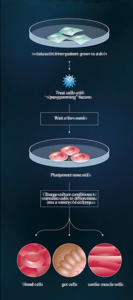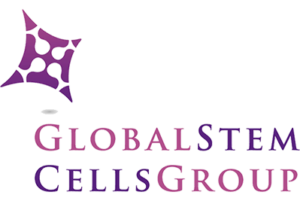Click on photo (at left) to enlarge
Photo: iPS cells feature – reprogrammed stem cells: Credit: Moscow Institute of Physics and Technology
Russian researchers have concluded that reprogramming does not create differences between reprogrammed and embryonic stem cells.
Stem cells are specialized, undifferentiated cells that can divide and have the remarkable potential to develop into many different cell types in the body during early life and growth. They serve as a sort of internal repair system in many tissues, dividing essentially without limit to replenish other cells. When a stem cell divides, each new cell has the potential either to remain a stem cell or become another more specialized cell type, such as a muscle cell, a red blood cell, or a brain cell. Scientists
distinguish several types of stem cells—pluripotent stem cells can potentially produce any cell in the body. No pluripotent stem cells exist in an adult body, rather they are found naturally in
early embryos.
There are two ways to harvest pluripotent stem cells. The first is to extract them from the excess embryos produced during invitro fertilization procedures, although this practice is still ethically and technically controversial because it does destroy an embryo that could have been implanted. For this reason, researchers came up with the second way to get pluripotent stem cells— reprogramming adult cells.
Reprogramming, the process of “turning on” genes that are active in a stem cell and “turning off” genes that are responsible for cell specialization was pioneered by Shinya Yamanaka, who showed that the introduction of four specific proteins essential during early embryonic development could be used to convert adult cells into pluripotent cells. Yamanaka was awarded the 2012 Nobel Prize along with Sir John Gurdon for the discovery that mature stem cells can be reprogrammed to become pluripotent.

Production of iPS cells:
• Isolate cells from patient; grow in a dish •
Treat cells with “reprogramming”
• Wait a few weeks
• Pluripotent stem cells
• Change culture conditions to stimulate cells to differentiate into a variety of cell types
• blood cells | gut cells | cardio muscle cells
Credit: Moscow Institute of Physics and Technology
Thanks to their unique regenerative abilities, stem cells offer potential for treating any disease. For example, there have been cases of transplanting retinal pigment epithelium and spine cells from stem cells. Another experiment showed that stem cells were able to regenerate teeth in mice. Reprogramming holds great potential for new medical applications, since reprogrammed pluripotent stem cells (or induced pluripotent stem cells) can be made from a patient’s own cells instead of using pluripotent cells from embryos.
However, the extent of the similarity between induced pluripotent stem cells and human embryonic stem cells remains unclear. Recent studies highlighted significant differences between these two types of stem cells, although only a limited number of cell lines of different origins were analyzed.
Researchers compared induced pluripotent stem cell (iPSC) lines reprogrammed from adult cell types that were previously differentiated from embryonic stem cells. All these cells were isogenic, meaning they all had the same gene set.
Scientists analyzed the transcriptome – the set of all products encoded, synthesized and used in a cell. Moreover, they elicited methylated DNA areas, because methylation plays a critical role in cell specialization. Comprehensive studies of changes in the gene activity regulation mechanism showed similarities between reprogrammed and embryonic stem cells. In addition, researchers produced a list of the activity of 275 key genes that can present reprogramming results.
Researchers studied three types of adult cells – fibroblasts, retinal pigment epithelium and neural cells, all of which consist of the same gene set; but a chemical modification (e.g. methylation) combined with other changes determines which part of DNA will be used for product synthesis.
Scientists concluded that the type of adult cells that were reprogrammed and the process of reprogramming did not leave any marks. Differences between cells that did occur were thought to be the result of random factors.
“We defined the best induced pluripotent stem cells line concept,” says Dmitry Ischenko, MIPT Ph.D. and Institute of Physical Chemical Medicine researcher.
The minimum number of iPSC clones that would be enough for at least one to be similar to embryonic pluripotent cells with 95 percent confidence is five.”
 Clearly, no one is going to convert embryonic stem cells into neurons and reprogram them into induced stem cells. Such a process would be too time-consuming and expensive. This experiment simulated the reprogramming of a patient’s adult cells into induced pluripotent stem cells for further medical use, and even though the reprogramming paper, published in the journal Cell Cycle, does not currently propose a method of organ growth in vitro, it is an important step in the right direction. Both induced pluripotent cells and embryonic stem cells can help researchers understand how specialized cells develop from pluripotent cells. In the future, they may also provide an unlimited supply of replacement cells and tissues that can benefit many patients with diseases that are currently untreatable.
Clearly, no one is going to convert embryonic stem cells into neurons and reprogram them into induced stem cells. Such a process would be too time-consuming and expensive. This experiment simulated the reprogramming of a patient’s adult cells into induced pluripotent stem cells for further medical use, and even though the reprogramming paper, published in the journal Cell Cycle, does not currently propose a method of organ growth in vitro, it is an important step in the right direction. Both induced pluripotent cells and embryonic stem cells can help researchers understand how specialized cells develop from pluripotent cells. In the future, they may also provide an unlimited supply of replacement cells and tissues that can benefit many patients with diseases that are currently untreatable.
The study, titled, “An integrative analysis of reprogramming in human isogenic system identified a clone selection criterion,” concluded that reprogramming does not create differences between reprogrammed and embryonic stem cells, involved researchers from the Vavilov Institute of General Genetics, Research Institute of Physical Chemical Medicine, and the Moscow Institute of Physics and Technology (MIPT).
###
